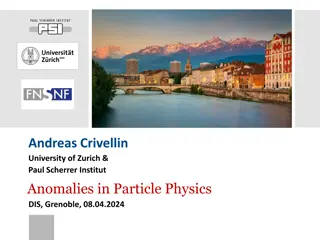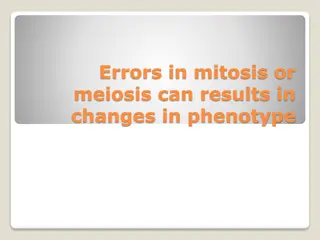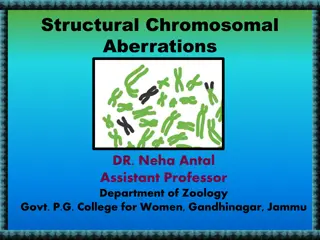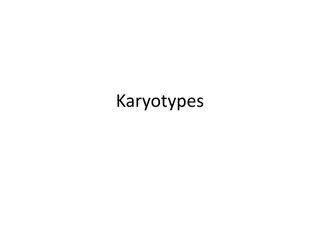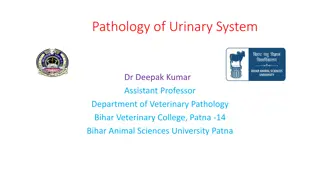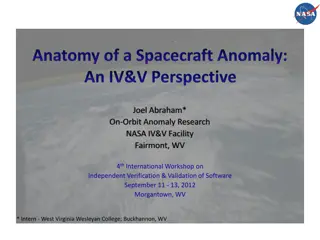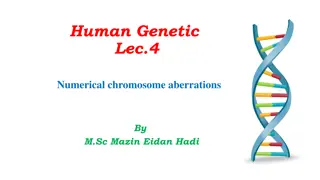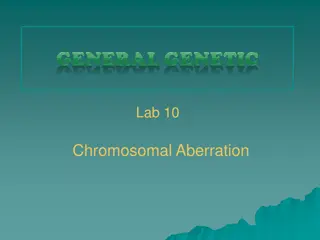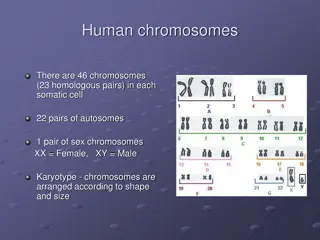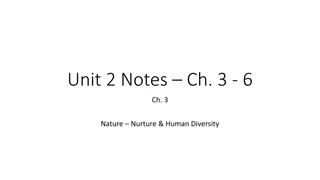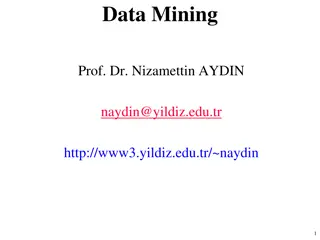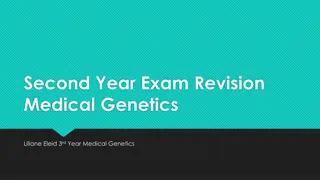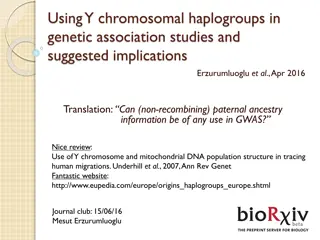Understanding Chromosomal Anomalies in Human Genetics
This lecture covers essential topics in human genetics, focusing on mitosis, meiosis, and chromosomal abnormalities. Students will learn about the events in mitosis and meiosis, non-disjunction, and classification of chromosomal anomalies, including numerical and structural abnormalities. Detailed explanations and new terminology are provided to enhance understanding.
Download Presentation

Please find below an Image/Link to download the presentation.
The content on the website is provided AS IS for your information and personal use only. It may not be sold, licensed, or shared on other websites without obtaining consent from the author. Download presentation by click this link. If you encounter any issues during the download, it is possible that the publisher has removed the file from their server.
E N D
Presentation Transcript
HUMAN GENETICS Color index: Important Slides Drs notes Explanation New terminology LECTURE 2: Chromosomal anomalies EDITION FILE EDITION FILE
OBJECTIVES By the end of this lecture, the students should be able to: 1. Describe and explain the events in mitosis & meiosis. 2. Define non-disjunction and describe its consequences on meiosis. 3. Classify chromosomal abnormalities: Numerical & structural - 3a Understand the common numerical autosomal disorders: trisomies 21, 13, 18. - 3b Understand the common numerical sex chromosome disorders: Turner`s & Klinefelter`s syndromes - 3c Recognize the main structural anomalies in chromosomes
Objective 1: Describe and explain the events in mitosis & meiosis. MITOSIS & MEIOSIS: TYPICAL MITOTIC CELL CYCLE one diploid duplication of each chromosome s DNA Two sister chromatids During G1 S phase S= synthesis of DNA chromosomes begin to condense and become visible G2 Phase G1, S, and G2 phases = constitute interphase Interphase > preparation for mitosis Cell cycle (G1 S G2 M) - Two daughter cells = equal genetic information The result is two diploid daughter cells with identical genetic information
Objective 1: Describe and explain the events in mitosis & meiosis. EVENTS OF MITOSIS Prophase. - formation of mitotic Spindle & pair of centrosomes Prometaphase. - Nuclear membrane dissolves - Chromosomes to disperse & attach by kinetochores to mitotic spindle microtubules Metaphase. Chromosomes condensed & line up at the equatorial plane Anaphase. - Chromosomes separate at centromere & - Sister chromatids of each chromosome become independent daughter chromosomes Telophase. - Chromosomes de-condense from their highly contracted state, - Nuclear membrane re-form around each of the two daughter nuclei. - Division of the cytoplasm - resume their interphase
Objective 1: Describe and explain the events in mitosis & meiosis. EVENTS OF MEIOSIS I & II Events of meiosis - Consists of tow successive nuclear division - In the first nuclear division the homologous chromosomes are separated from each other (daughter chromosomes consists of two chromatids ) - The second nuclear division resembles a mitotic division but there is no DNA replication (already replicated before the first division ) - The result is four haploid daughter cells Note that the anaphase occurs once in mitosis and twice in meiosis
Objective 1: Describe and explain the events in mitosis & meiosis. Meiosis Vs. Mitosis File:Haploid, diploid ,triploid and tetraploid.svg File:Haploid, diploid ,triploid and tetraploid.svg Normal Gametes 4 Haploids
Objective 1: Describe and explain the events in mitosis & meiosis. Meiosis
Objective 2: Non-disjunction and its impact on meiosis. NON-DISJUNCTION IN MEIOSIS - The failure of chromosomes to disjoin normally during meiosis phase 1 or phase 2. - Two chromosome homologs migrate to the same daughter cell instead of disjoining normally and migrating to different daughter cells. - The result of this error is a cell with an imbalance of chromosomes (Aneuploidy) A normal disjunction in first meiotic division produces 4 balanced gametes Can affect each pair of chromosomes is not a rare event Non disjunction in first meiotic division produces 4 unbalanced gametes. Non disjunction in second division produces 2 normal gametes & 2 unbalanced gametes: Gamete with an extra autosome Nullosomic gamete (missing one chromosome)
Objective 2: Non-disjunction and its impact on meiosis. In meiotic nondisjunction - This product of fertilization with normal gamete would be monosomic and trisomic offspring (Aneuploidy) Presence of an abnormal number of chromosomes in a cell
Objective 3: Classifications of chromosomal abnormalities CHROMOSOME ANOMALIES Affect the structure and organization of genomic content of the chromosome affect the number of complete haploid set (n) of chromosomes CHROMOSOME ANOMALIES Structural Numerical Ring Reciprocal translocation Robertsonian translocation Sex Deletion Inversion Isochromosome autosomes formation chromosomes - Down syndrome - Edward's syndrome - Patau Syndrome - Turner s syndrome - Klinefelter Syndrome - In structural The structure of the chromosome has been affected - In numerical Excess or loss of the chromosome
Objective 3a: Understand the common numerical autosomal disorders: trisomies 21, 13, 18 NUMERICAL CHROMOSOMAL ANOMALIES "NUMERICAL ANOMALIES IN AUTOSOMES" Down syndrome, Trisomy 21 Karyotype: 47, XY, +21 Edward's syndrome, Trisomy 18 Karyotype: 47, XY, +18 Patau syndrome, Trisomy 13 Karyotype: 47, XY, +13 the second most common autosomal trisomy, after Down syndrome. It occurs in around one in 6,000 live births. Most babies die in the first year and many within the first month & has a very low rate of survival. Common anomalies are heart abnormalities, kidney malformations, and other internal organ disorders. Most cases arise from non-disjunction in the first meiotic division. The incidence of trisomy 21 rises sharply with increasing maternal age. The father contributing the extra chromosome in 15% of cases. The symptoms include characteristic facial dysmorphologies, and an IQ of less than 50. The maternal age of the ovum is the determinant of this abnormality. There are multiple dysmorphic features. Most cases, as in Patausyndrome, involve maternal non-disjunction. 50 % of these babies die within the first month and very few survive beyondthe first year. The genomic content on chromosome 13 is very critic, so this syndrome is less popular than trisomy +21.
Objective 3a: Understand the common numerical autosomal disorders: trisomies 21, 13, 18 NUMERICAL CHROMOSOMAL ANOMALIES "NUMERICAL ANOMALIES IN AUTOSOMES" Down syndrome, Trisomy 21 Patau syndrome, Trisomy 13 Edward's syndrome, Trisomy 18
Objective 3b: Understand the common numerical sex chromosome disorders: Turner`s & Klinefelter`s syndromes NUMERICAL CHROMOSOMAL ANOMALIES "NUMERICAL ANOMALIES IN SEX CHROMOSOMES " Turner ssyndrome (Monosomy X Karyotype: 45,XO,females Klinefelter Syndrome Karyotype: 47,XXY males ( 1/600 males, due to nondisjunction of X chromosomes during meiosis I in females. (maternal) Male sex organs; unusually small testes which fail to produce normal levels of testosterone breast enlargement (gynaecomastia body characteristic. Patients are taller and thinner than average and may have a slight reduction in IQ but generally they have normal intelligence. No spermatogenesis sterile This one is caused by the mother. Occurring in 1 in 4000 phenotypic females. As a result of paternal meiotic nondisjunction. The only viable " Characteristics: Webbed genetically female, not mature sexually, Sterile stature " " , Broad chest, Low hairline, Streak ovaries, Normal intelligence, Normal life span. monosomy in humans. " neck, Individuals are " " ) and other feminine , Short " " " " The dominant of this abnormality is the paternal genetic material(most of the time), so it may be maternal sometimes. X
Objective 3b: Understand the common numerical sex chromosome disorders: Turner`s & Klinefelter`s syndromes NUMERICAL CHROMOSOMAL ANOMALIES "NUMERICAL ANOMALIES IN SEX CHROMOSOMES " * . ) (
Objective 3: Classify chromosomal abnormalities: Numerical MOSAICISM The presence of more than one genetically distinctcell line in the body. A mosaic individual is made of 2 (or more) cell populations, coming from only 1 zygote. Is denoted by a slash between the various clones observed Numerical mosaic anomaly is usually due to a mitotic non-disjunction. A mosaic must not be confused with a chimeras. e.g.(46, XY / 47, XY, +21). " " What s the difference between mosaicism and the chimerism? Chimerism is the presence in an individual of two or more genetically distinct cell lines derive from more than one zygote (e.g. 2 sperms fertilize 2 ova 2 zygotes that fuse to form 1 embryo.) This abnormality (mosaicism) well develop after fertilization as a non-disjunction abnormality in the zygote. While in chimerism there s two normal zygotes are fused together. Chimerism isn t important for us (in exam) but it s mentioned to let us know the deference between them .
Objective 3c: Recognize the main structural anomalies in chromosomes STRUCTURAL CHROMOSOMAL ANOMALIES Translocation Reciprocal translocation Robertsonian translocation - Reciprocal translocation between chromosome 22 and the long arm of chromosome 9 (the Philadelphia chromosome). - The occurrence of this translocation in hematopoietic cells can produce chronic myelogenous leukemia (CML) - Short arms of two non homologous chromosomes are lost and the long arms fuse at the centromere to form a single chromosome - Confined to the acrocentric chromosomes(13, 14, 15, 21, and 22) - Although carriers have only 45 chromosomes in each cell, they are phenotypically unaffected
3c Recognize the main structural anomalies in chromosomes Objective 3c: Recognize the main structural anomalies in chromosomes STRUCTURAL CHROMOSOMAL ANOMALIES Deletion Terminal deletion Interstitial deletion Deletion Loss of a segment from a chromosome, either terminal or interstitial Invariably, but not always, results in the loss of important genetic material Deletion is therefore an unbalanced rearrangement. Indicated in nomenclature del Sample karyogram ofInterstitial deletion Sample karyogram ofTerminal deletion 46,XX,del(18)(q21.3) 46,XY,del(7)(q11.23q21.2) karyotype description is as follows: - 46: the total number of chromosomes. - XY: the sex chromosomes (male). - del(7): deletion in chromosome 7. - (q11.23q21.2): breakpoints of the deleted segment.
3c Recognize the main structural anomalies in chromosomes Objective 3c: Recognize the main structural anomalies in chromosomes STRUCTURAL CHROMOSOMAL ANOMALIES Inversion, isochromosome, and ring chromosome Ring formation(Ring chromosome) Isochromosome Inversion - Occurs when a segment of chromosome breaks, and rejoining within the chromosome effectively. The most probable explanation for isochromosome is that the centromere has divided transversely rather than longitudinally - A break on each arm of a chromosome - Two sticky ends - Reunion of the ends as a ring loss of the 2 distal chromosomal fragments - Written in nomenclature as inv. - Ring chromosomes are often unstable in mitosis - Only large inversions are normally detected. They are balance rearrangements that rarely cause problems in carriers Isochromosome Normal Pericentric Paracentric Isochromosome Normal
TAKE HOME MESSAGES Chromosome abnormalities can be numerical or structural. Normal meiotic division result in four haploid gametes In trisomy, a single extra chromosome is present, usually as a result of non-disjunction in the 1st or 2nd meiotic division. Mosaicism arise from one zygote while Chimera from the fusion of two fertilized eggs Structural abnormalities include translocations (balanced or unbalanced), inversions, deletions, isochromosome & rings.
MCQ 4- Which syndrome is known as Trisomy 18? A- Down Syndrome B- Patau Syndrome C- Edward Syndrome D- Klinefelter Syndrome 1- During which phase of the cell cycle DNA is replicated? A- G1 B- S C- G2 D- none of the above 5- Fail to produce normal levels of testosterone is a characteristic of A- Turnur s Syndrome B- Klinefelter Syndrome C- Edward Syndrome D- Patau Syndrome 2- Nuclear membrane dissolves at A- Prophase B- Telophase C- Metaphase D- Prometaphase 6- Which of the following chromosome abnormalities is known as Turner Syndrome? A- 47, XXY B- 44, XO C- Trisomy 18 D- Trisomy 21 3- Non disjunction in second division produces A- 2 unbalanced gametes B- 2 normal gametes C- 2 unbalanced gametes and 2 normal gametes D- 4 unbalanced gametes
MCQ 9 - Presence of an abnormal number of chromosomes in a cell known as A- Aneuploidy B- Mosaicism C- Chimerism D- None of the above 1 B 2 D 3 C 4 C 5 B 6 B 7 A 8 D 9 A 10 B 11 C 7- Occurs when a segment of chromosome breaks, and rejoining within the chromosome effectively: A- Inversion B- Isochromosome C- Ring Formation D- Deletion 10- is a result of maternal non-disjunction. A- Turner s Syndrome B- Klinefelter Syndrome C- Edward Syndrome D- none of the above 8- Loss of a segment from a chromosome, either terminal or interstitial A- Inversion B- Isochromosome C- Ring Formation D- Deletion 11- Meiosis result in A- 2 haploid daughter cells B- 2 diploid daughter cells C- 4 haploid daughter cells D- 4 diploid daughter cells
TEAM LEADERS: Abdulmajeed Alwardi Haifa Alessa GIRLS TEAM: Ghaida Alsanad Munira Alhadlg Batoul Alruhaimi Dimah Alaraifi Arjuwana Alaqeel Marwah Alkhalil BOYS TEAM: Abdullah Alzahrani Abdulaziz Aljohani Adel Alzahrani Hamdan Aldossri GeneticsTeam437@gmail.com :



